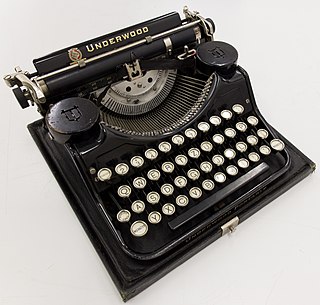
A typewriter is a mechanical or electromechanical machine for typing characters. Typically, a typewriter has an array of keys, and each one causes a different single character to be produced on paper by striking an inked ribbon selectively against the paper with a type element. Thereby, the machine produces a legible written document composed of ink and paper. By the end of the 19th century, a person who used such a device was also referred to as a typewriter.

Daisy wheel printing is an impact printing technology invented in 1970 by Andrew Gabor at Diablo Data Systems. It uses interchangeable pre-formed type elements, each with typically 96 glyphs, to generate high-quality output comparable to premium typewriters such as the IBM Selectric, but two to three times faster. Daisy wheel printing was used in electronic typewriters, word processors and computers from 1972. The daisy wheel is so named because of its resemblance to the daisy flower.

The IBM Electric were an early series of electric typewriters that IBM manufactured, starting in the mid-1930s. They used the conventional moving carriage and typebar mechanism, as opposed to the fixed carriage and type ball used in the IBM Selectric, introduced in 1961. After 1944, each model came in both "Standard" and "Executive" versions, the latter featuring proportional spacing.

Orient is a Japanese watch manufacturer founded in 1950. Established as an independent company in 1950, it became a functional subsidiary of Epson in 2009 before being fully integrated into the company in 2017.

Olivetti S.p.A. is an Italian manufacturer of computers, tablets, smartphones, printers and other such business products as calculators and fax machines.

The Friden Flexowriter was a teleprinter produced by the Friden Calculating Machine Company. It was a heavy-duty electric typewriter capable of being driven not only by a human typing, but also automatically by several methods, including direct attachment to a computer and by use of paper tape.

Seiko Epson Corporation, commonly known as Epson, is a Japanese multinational electronics company and one of the world's largest manufacturers of printers and information- and imaging-related equipment. Headquartered in Suwa, Nagano, Japan, the company has numerous subsidiaries worldwide and manufactures inkjet, dot matrix, thermal and laser printers for consumer, business and industrial use, scanners, laptop and desktop computers, video projectors, watches, point of sale systems, robots and industrial automation equipment, semiconductor devices, crystal oscillators, sensing systems and other associated electronic components.
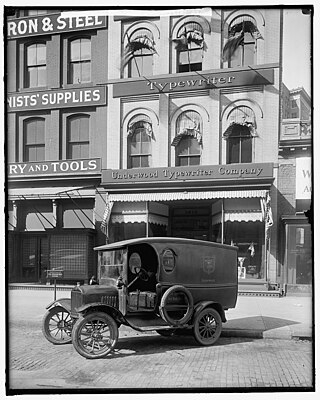
The Underwood Typewriter Company was an American manufacturer of typewriters headquartered in New York City, with manufacturing facilities in Hartford, Connecticut. Underwood produced what is considered the first widely successful, modern typewriter. By 1939, Underwood had produced five million machines.

The Diablo 630 is a discontinued daisy wheel style computer printer sold by the Diablo Data Systems division of the Xerox Corporation beginning in 1980. The printer is capable of letter-quality printing; that is, its print quality is equivalent to the quality of an IBM Selectric typewriter or printer, the de facto quality standard of the time.

Brother Industries, Ltd. (stylized in lowercase) is a Japanese multinational electronics and electrical equipment company headquartered in Nagoya, Japan. Its products include printers, multifunction printers, desktop computers, consumer and industrial sewing machines, large machine tools, label printers, typewriters, fax machines, and other computer-related electronics. Brother distributes its products both under its own name and under OEM agreements with other companies.

The Olivetti Lettera 22 is a portable mechanical typewriter designed by Marcello Nizzoli in 1949 or, according to the company's current owner Telecom Italia, 1950. This typewriter was very popular in Italy, receiving the Compasso d'Oro prize in 1954. In 1959 the Illinois Institute of Technology chose the Lettera 22 as the best designed product of the last 100 years.
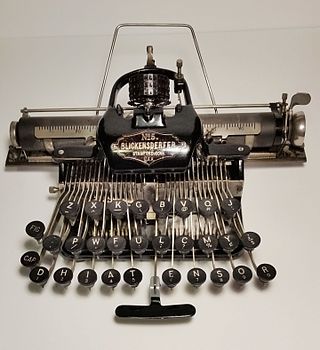
The Blickensderfer typewriter was invented by George Canfield Blickensderfer (1850–1917) and patented on April 12, 1892. Blickensderfer was a nephew of John Celivergos Zachos, the inventor of the stenotype. Two models, Model 1 and Model 5, were unveiled to the public at the 1893 World's Columbian Exposition in Chicago. The Model 5 was a stripped-down version of the bigger, more complex Model 1. These machines were intended to compete with larger Remington, Hammond and Yost typewriters, and were the first truly portable, full-keyboard typewriters. The design also enabled the typist to see the typed work, at a time when most typewriters were understrike machines that concealed the writing. When Blickensderfer unveiled his small Model 5, its compactness and novel features attracted huge crowds and many orders.
The Royal Typewriter Company is a manufacturer of typewriters founded in January 1904. It was headquartered in Hartford, Connecticut.
Seiko is a brand name for Japanese clock and watch company Seiko Holdings Corporation.
Smith Corona is an American manufacturer of thermal labels, direct thermal labels, and thermal ribbons used in warehouses for primarily barcode labels.
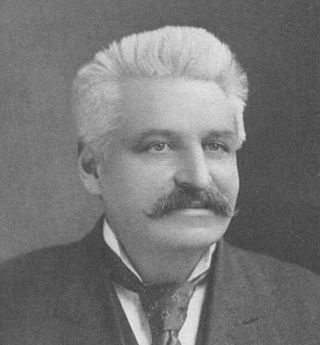
The Oliver Typewriter Company was an American typewriter manufacturer headquartered in Chicago, Illinois. The Oliver Typewriter was one of the first "visible print" typewriters, meaning text was visible to the typist as it was entered. Oliver typewriters were marketed heavily for home use, using local distributors and sales on credit. Oliver produced more than one million machines between 1895 and 1928 and licensed its designs to several international firms.
Olivetti is an Italian manufacturer of computers, tablets, smartphones, printers, calculators, and fax machines. It was founded as a typewriter manufacturer by Camillo Olivetti in 1908 in the Turin commune of Ivrea, Italy.

The IBM Selectric was a highly successful line of electric typewriters introduced by IBM on 31 July 1961.
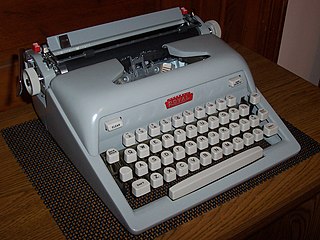
The Royal Futura is a portable, manual typewriter that was produced and sold from 1958 to 1962, by the Royal Typewriter Company division of Royal McBee Corporation. In appearance, features, and pricing, the introduction of the Futura marked a new direction in the production of Royal portable typewriters. Sales were supported by an aggressive print advertising campaign directed at students, and the Futura itself was heavily discounted towards the end of its run. The radical new design eventually found its way onto other Royal models throughout the early and mid-1960s, and the name "Futura" would appear on another model later in decade.
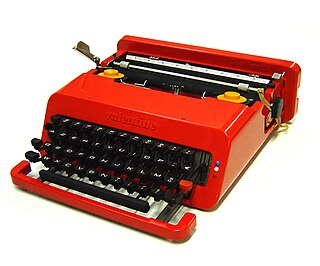
The Olivetti Valentine is a portable, manual typewriter manufactured and marketed by the Italian company, Olivetti, that combined the company's Lettera 32 internal typewriter mechanicals with signature red, glossy plastic bodywork and matching plastic case. Designed in 1968 by Olivetti's Austrian-born consultant, Ettore Sottsass, assisted by Perry A. King and Albert Leclerc – it was introduced in 1969 and was one of the earliest and most iconic plastic-bodied typewriters.


















